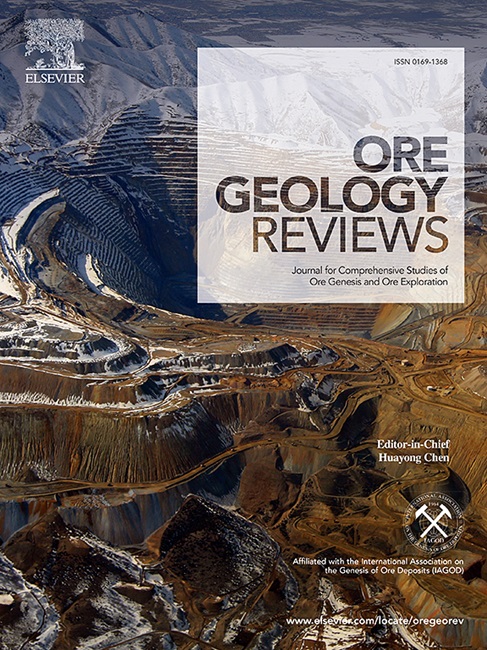Genesis and evolution of the Dajing tin-copper polymetallic deposit in Inner Mongolia: Constraints from geochronology, mineral composition, and S-Pb-H-O isotopes
IF 3.2
2区 地球科学
Q1 GEOLOGY
引用次数: 0
Abstract
Most tin mineralization shows a strong spatial and temporal association with Cu-Pb-Zn polymetallic mineralization. Tin mineralization typically occurs as porphyry, skarn, or quartz veins at depth, whereas the base metal ore bodies are found in shallower part and controlled by fault. However, not all Cu-Pb-Zn deposits exhibit significant tin mineralization, and the evolution of tin in base metal deposits remains unclear. The Dajing tin polymetallic deposit (Sn 0.08Mt., Cu 0.33Mt., Pb + Zn 2Mt), provides an ideal opportunity to address this question. Three primary stages of mineralization containing three generations of cassiterite and two generations of chalcopyrite have been identified in the Dajing deposit: (1) Sn-As mineralization stage (Cst1a and Cst1b); (2) Cu-Zn mineralization stage (Cst2 and Ccp1); and (3) Pb-Zn-Ag mineralization stage (Ccp2). The U-Pb dating of two cassiterite samples from quartz-cassiterite and cassiterite-sulfide ore bodies yielded Tera-Wasserburg lower intercept ages of 161.3 ± 5.5 Ma and 162.8 ± 4.9 Ma, respectively, indicating that the Dajing deposit formed during the Middle to Late Jurassic. The chemical composition of cassiterite indicates that it was formed in a physicochemical environment with a relatively low temperature (∼ 350 °C) and low oxygen fugacity (Log fO2≈-35) compared with the proximate metallogenic system, such as granite-type and skarn-type deposits. We propose that tin-arsenic co-precipitation and sustained temperature cooling are effective mechanisms leading to the large-scale formation of cassiterite. The signal curves of laser ablation and the correlation of trace elements in Sn-enriched chalcopyrite indicate that Sn occupies the mineral lattice positions of Cu or Fe through the isomorphism mechanism in Ccp1 of the Cu-Zn stage, while occurring as the form of nanoscale stannite inclusions in Ccp2 of the Pb-Zn-Ag stage. The S-Pb-H-O isotopic compositions indicate that metals such as tin, copper, lead, and zinc may be sourced from magmatic-hydrothermal fluids associated with the Jurassic magmatism. A new model has been developed to highlight the various forms of tin accumulation and evolution at different mineralization stages. In combination with the geological characteristics, the above results suggest that the Dajing deposit is a magma-related cassiterite-sulfide hydrothermal vein-type deposit, and indicate the prospect of further exploration for tin mineralization near and/or under the Dajing mining area.

求助全文
约1分钟内获得全文
求助全文
来源期刊

Ore Geology Reviews
地学-地质学
CiteScore
6.50
自引率
27.30%
发文量
546
审稿时长
22.9 weeks
期刊介绍:
Ore Geology Reviews aims to familiarize all earth scientists with recent advances in a number of interconnected disciplines related to the study of, and search for, ore deposits. The reviews range from brief to longer contributions, but the journal preferentially publishes manuscripts that fill the niche between the commonly shorter journal articles and the comprehensive book coverages, and thus has a special appeal to many authors and readers.
 求助内容:
求助内容: 应助结果提醒方式:
应助结果提醒方式:


